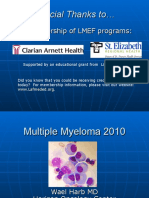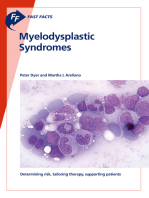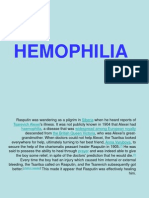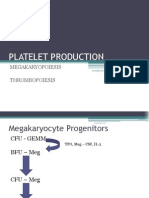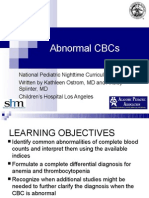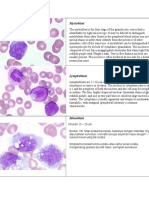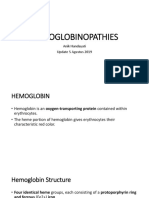0 ratings0% found this document useful (0 votes)
141 viewsMultiple Myeloma
Multiple Myeloma
Uploaded by
bubbu92This document summarizes plasma cell disorders like monoclonal gammopathy of undetermined significance (MGUS), solitary plasmacytoma, multiple myeloma, and amyloidosis. It provides criteria for diagnosing active multiple myeloma, including anemia, bone lesions, high calcium, or kidney dysfunction. Risk of progression from MGUS is about 1% per year. Treatment options for multiple myeloma include chemotherapy, stem cell transplantation, radiotherapy, and newer drugs like bortezomib and lenalidomide. Prognostic factors include high beta-2 microglobulin and deletion of chromosome 13.
Copyright:
© All Rights Reserved
Available Formats
Download as PPT, PDF, TXT or read online from Scribd
Multiple Myeloma
Multiple Myeloma
Uploaded by
bubbu920 ratings0% found this document useful (0 votes)
141 views23 pagesThis document summarizes plasma cell disorders like monoclonal gammopathy of undetermined significance (MGUS), solitary plasmacytoma, multiple myeloma, and amyloidosis. It provides criteria for diagnosing active multiple myeloma, including anemia, bone lesions, high calcium, or kidney dysfunction. Risk of progression from MGUS is about 1% per year. Treatment options for multiple myeloma include chemotherapy, stem cell transplantation, radiotherapy, and newer drugs like bortezomib and lenalidomide. Prognostic factors include high beta-2 microglobulin and deletion of chromosome 13.
Original Description:
multiple myeloma slides from medical school
Original Title
multiple myeloma
Copyright
© © All Rights Reserved
Available Formats
PPT, PDF, TXT or read online from Scribd
Share this document
Did you find this document useful?
Is this content inappropriate?
This document summarizes plasma cell disorders like monoclonal gammopathy of undetermined significance (MGUS), solitary plasmacytoma, multiple myeloma, and amyloidosis. It provides criteria for diagnosing active multiple myeloma, including anemia, bone lesions, high calcium, or kidney dysfunction. Risk of progression from MGUS is about 1% per year. Treatment options for multiple myeloma include chemotherapy, stem cell transplantation, radiotherapy, and newer drugs like bortezomib and lenalidomide. Prognostic factors include high beta-2 microglobulin and deletion of chromosome 13.
Copyright:
© All Rights Reserved
Available Formats
Download as PPT, PDF, TXT or read online from Scribd
Download as ppt, pdf, or txt
0 ratings0% found this document useful (0 votes)
141 views23 pagesMultiple Myeloma
Multiple Myeloma
Uploaded by
bubbu92This document summarizes plasma cell disorders like monoclonal gammopathy of undetermined significance (MGUS), solitary plasmacytoma, multiple myeloma, and amyloidosis. It provides criteria for diagnosing active multiple myeloma, including anemia, bone lesions, high calcium, or kidney dysfunction. Risk of progression from MGUS is about 1% per year. Treatment options for multiple myeloma include chemotherapy, stem cell transplantation, radiotherapy, and newer drugs like bortezomib and lenalidomide. Prognostic factors include high beta-2 microglobulin and deletion of chromosome 13.
Copyright:
© All Rights Reserved
Available Formats
Download as PPT, PDF, TXT or read online from Scribd
Download as ppt, pdf, or txt
You are on page 1of 23
Rajkumar SV, et al. Blood. 2005;106:812-817.
Plasma cell disorders
MGUS
Solitary plasmacytoma (bone or extramedullary)
Multiple myeloma
Amyloidosis
Waldenstrom macroglobulinemia
Criteria for Diagnosis of Myeloma
MGUS
< 3 g/dL M spike
< 10% PC
Active MM
3 g M spike
OR: 10% PC
No anemia, no bone lesions;
normal calcium and
kidney function
Anemia, bone lesions,
high calcium, or
abnormal kidney function
(CRAB criteria) + amyloidosis,
recurrent bacterial infections
Smoldering MM
10% PC
M spike +
AND AND
Rajkumar SV, et al. Blood. 2005;106:812-817.
Risk of Progression of MGUS
1148 patients with MGUS followed for 8982
person-yrs
Median follow-up: 15 yrs
7.6% of patients experienced progression during
observation
Cumulative probability of progression ~ 1% per yr
At 10 yrs: 9%
At 20 yrs: 20%
At 25 yrs: 30%
Multiple myeloma
malignant proliferation of plasma cells derived by only one
clone
3800 new cases every
year in the UK
Incidence:
6/100,000/year
Age at diagnosis: 60-70
Multiple myeloma
etiology and pathogenesis
Radiation, farmers, petroleum worker. More
common in blacks.
Errors in IgH switch recombination t(11;14),
t(4;14), myc ras p53, BRAF gene sometimes
involved. Critical role of IL6, IGF-1, VEGF.
Theory of clonal tides.
Role of microenvironment.
Epidemiology of Multiple Myeloma
~ 20,180 new cases and 10,650 deaths from
multiple myeloma are expected in the United
States in 2010
Slightly more common in men than in women
Incidence in blacks is ~ twice than that in whites
Median age at diagnosis is 69 yrs for men and 71
yrs for women
75% of men are older than 70 yrs of age
79% of women are older than 70 yrs of age
Cancer facts and figures 2010. American Cancer Society; 2010. Altekruse SF, et al, eds. SEER cancer
statistics review, 1975-2007. National Cancer Institute. NCCN practice guidelines. 2011.
Distribution of Monoclonal Proteins
in Multiple Myeloma
M protein found in serum and/or urine or both
at time of diagnosis in 97% of patients (3% are
nonsecretory)
Of the 3% with nonsecretory myeloma with
negative serum and urine immunofixation,
60% will have detectable serum free light
chains on the serum free light chain assay
Kyle RA ,et al. Mayo Clin Proc. 2003;78:21-33. IMWG. Br J Haematol. 2003;121:749-757.
Jacobson Jl, et al. Br J Haematol. 2003;122:441-450.
Clinical features
Bone lesions bone pain,
bone fractures, spinal cord
compression
Bone marrow involvement
Anemia
Kidney failure
Hypercalcemia
Infections
M component 70-75%
Light chain only 20 -22 %
2-3 % non secretory
Major Symptoms at Diagnosis
Bone pain: 58%
Fatigue: 32%
Weight loss: 24%
Paresthesias: 5%
11% are asymptomatic or have only mild
symptoms at diagnosis
Kyle RA, et al. Mayo Clin Proc. 2003;78:21-33.
Clinical Features at Presentation
M serum protein (93%)
Lytic bone lesions (67%)
Increased plasma cells in the bone marrow (96%)
Anemia (normochromic normocytic) (73%)
Hypercalcemia (corrected calcium 11 mg/dL)
(13%)
Renal failure, serum creatinine 2.0 mg/dL (19%)
Infection
Kyle RA, et al. Mayo Clin Proc. 2003;78:21-33.
Initial Diagnostic Evaluation
History and physical examination
Blood workup
CBC with differential and platelet
counts
BUN, creatinine
Electrolytes, calcium, albumin, LDH
Serum quantitative immunoglobulins
Serum protein electrophoresis
and immunofixation
2
-microglobulin
Serum free light chain assay
proBNP
Urine
24-hr protein
Protein electrophoresis
Immunofixation
electrophoresis
Other
Skeletal survey
Unilateral bone marrow
aspirate and biopsy evaluation
with immunohistochemistry
and/or bone marrow flow
cytometry, cytogenetics, and
FISH
MRI (spine, pelvis) as indicated
NCCN practice guidelines. 2011.
Categories of Myeloma
Classification Characteristics Management
Indolent MM Presence of serum/urine M protein
Bone marrow plasmacytosis
Mild anemia or few small dubious bone lesions
(skull)
Absence of symptoms
Monitoring every
3 mos, with treatment
beginning at disease
progression
Symptomatic MM Presence of serum/urine M protein
Bone marrow plasmacytosis
Anemia, renal failure, hypercalcemia, or
lytic bone lesions
Patients with primary systematic amyloidosis and
bone marrow plasma cells 30% are considered
to have both MM and amyloidosis
Immediate treatment
IMWG. Br J Haematol. 2003;121:749-757.
Durie-Salmon Staging System for
Myeloma
Subclassification Criteria
A Normal renal function (serum creatinine level < 2.0 mg/dL)
B Abnormal renal function (serum creatinine level 2.0 mg/dL)
Durie B, et al. Cancer. 1975;36:842-854. IMWG. Br J Haematol. 2003;121:749-757.
Stage Criteria Myeloma Cell Mass
(x 10
12
cells/m
2
)
I All of the following:
Hemoglobin > 10 g/dL
Serum calcium level 12 mg/dL (normal)
Normal bone or solitary plasmacytoma on x-ray
Low M component production rate: IgG < 5 g/dL; IgA < 3 g/dL;
Bence-Jones protein < 4 g/24 hrs
< 0.6 (low)
II Not fitting stage I or III 0.6-1.2 (intermediate)
III 1 or more of the following:
Hemoglobin < 8.5 g/dL
Serum calcium level > 12 mg/dL
Multiple lytic bone lesions on x-ray
High M-component production rate: IgG > 7 g/dL; IgA > 5 g/dL;
Bence-Jones protein > 12 g/24 hrs
> 1.2 (high)
International Staging System for
Symptomatic Myeloma
Stage Criteria
1
2
-M < 3.5 mg/dL and
ALB 3.5 g/dL
2 Not stage 1 or 3
3
2
-M 5.5 mg/dL
Greipp PR, et al. J Clin Oncol. 2005;23:3412-3420.
Major Adverse Prognostic Factors
Karyotypic deletion 13 or hypodiploidy
High plasma cell labeling index
Molecular genetics: t(4;14), t(14;16), cr 1 or
17p-
High LDH,
2
-microglobulin
Increased circulating plasma cells
Plasmablastic morphology
Low albumin
IMWG Classification of Active MM
High Risk (25%)
FISH
Del 17p
t(4;14)*
t(14;16)
Cytogenetic deletion 13q
Cytogenetic
hypodiploidy
PCLI 3%
Standard Risk (75%)*
All others, including:
Hyperdiploidy
t(11;14)
t(6;14)
Dispenzieri A, et al. Mayo Clin Proc. 2007;82:323-341. Fonseca R, et al. Leukemia. 2009;23:2210-2221.
*Patients with t(4;14),
2
-M < 4 mg/L and Hb 10 g/dL may have intermediate-risk disease.
Initial Therapy Considerations
Ensure patient does not have smoldering MM
(asymptomatic MM) since no treatment proven
effective, although clinical trials are ongoing
Approach to therapy for MM is based on whether
a patient is a transplantation candidate
Patients seeking care within the VHA system
typically present with more comorbidities than in
other settings
Consider clinical trials if available
Improving CR rates is a key goal of current trials
Treatment
Combination chemotherapy
Steroids
Cyclophosphamide
Thalidomide
Anthracycline
High-dose chemotherapy with SC rescue
Radiotherapy
Bisphosphonates
EPO
Surgery (kyphoplasty)
New drugs
Bortezomib
Lenalidomide
Criteria for Transplantation
Younger than 70 yrs of age
High performance score
Acceptable function
Major organs
Neuropsychiatric
Acceptable social circumstances
Caregiver
Absence of drug/alcohol addiction
VHA clinical guidance for the initial management of adults with MM. August 2009.
Clearly not transplantation
candidate based on age, performance
score, AND/OR comorbidity
MPT, MPV,
or clinical trial
Potential transplantation
candidate
VDT x 4 cycles
Stem cell harvest
Initial Approach to Treatment of
MM
Current Frontline Options
Conventional chemotherapy
Survival 3 yrs
Transplantation
Prolongs survival 5 -7 yrs
Novel agents targeting stromal interactions
and associated signaling pathways have shown
promise
Chng WJ, et al. Cancer Control. 2005;12:91-104.
Rajkumar SV, et al. Blood. 2005;106:812-817.
Waldenstrom macroglobulinemia
Lymphoplasmacytoid lymphoma
IgM production
Hyperviscosity
Bone marrow infiltration, non bone lesions, no renal
failure
Positive Coombs test, cryoglobulins
Sign and Symptoms
Fatigue, dizziness, visual disturbance, peripheral
neuropathy, infections, adenopathies, epato-
splenomegaly
Rajkumar SV, et al. Blood. 2005;106:812-817.
Solitary plasmacytoma
Bone or upper respiratory tract
M component production
Normal bone marrow
Sign and Symptoms
Local or compression symptoms, bone pain,
neuologic signs
You might also like
- Intimacy Educator: Teaching Through Touch - By: Caffyn JesseDocument196 pagesIntimacy Educator: Teaching Through Touch - By: Caffyn JesseHarmony Jorden100% (6)
- Who 2016Document35 pagesWho 2016Herlina InaNo ratings yet
- MDSDocument46 pagesMDSFesti Mada HelmiNo ratings yet
- MMDocument67 pagesMMRatnaNo ratings yet
- MULTIPLE MYELOMA For Medical Students. Copy - 032148Document39 pagesMULTIPLE MYELOMA For Medical Students. Copy - 032148Miracle Odenigbo100% (2)
- The Many Faces of Monoclonal GammopathiesDocument44 pagesThe Many Faces of Monoclonal GammopathiesimagigatoNo ratings yet
- Multiple Myeloma: Presented By: DR - Ramesh Kumar Guide:-Dr. O.P. Meena SirDocument65 pagesMultiple Myeloma: Presented By: DR - Ramesh Kumar Guide:-Dr. O.P. Meena Sirvikash meenaNo ratings yet
- Fast Facts: Measurable Residual Disease: A Clearer Picture for Treatment DecisionsFrom EverandFast Facts: Measurable Residual Disease: A Clearer Picture for Treatment DecisionsNo ratings yet
- Fast Facts: Myelodysplastic Syndromes: Determining Risk, Tailoring Therapy, Supporting PatientsFrom EverandFast Facts: Myelodysplastic Syndromes: Determining Risk, Tailoring Therapy, Supporting PatientsNo ratings yet
- Fast Facts: Acute Myeloid Leukemia: New Modular Targets - First New Treatment for decadesFrom EverandFast Facts: Acute Myeloid Leukemia: New Modular Targets - First New Treatment for decadesNo ratings yet
- PPT MA - RevisiDocument76 pagesPPT MA - RevisiullifannuriNo ratings yet
- HemoglobinopatiDocument40 pagesHemoglobinopatiHenni Junita Siregar SorminNo ratings yet
- CP - Hemophilia 2Document40 pagesCP - Hemophilia 2Reezka PutraNo ratings yet
- Acute Promyelocytic LeukemiaDocument46 pagesAcute Promyelocytic LeukemiaKartthik ShanmugamNo ratings yet
- Pancytopenia As Initial Presentation of Acute Lymphoblastic Leukemia and Its Associationwith Bone MarrowresponseDocument6 pagesPancytopenia As Initial Presentation of Acute Lymphoblastic Leukemia and Its Associationwith Bone MarrowresponseIJAR JOURNALNo ratings yet
- Pendukung Mikroalbuminuria, Kreatini, UcrDocument21 pagesPendukung Mikroalbuminuria, Kreatini, UcrHesty AshanNo ratings yet
- Haem 2 Revision Sept 2010Document170 pagesHaem 2 Revision Sept 2010saint5470100% (1)
- Para Protein Emi ADocument14 pagesPara Protein Emi AMohamoud MohamedNo ratings yet
- Anemia Penyakit KronikDocument12 pagesAnemia Penyakit KronikFaridhatulNo ratings yet
- HepatitisDocument46 pagesHepatitisGusti Tirtha Drag JrNo ratings yet
- Plasma Proteins 1Document46 pagesPlasma Proteins 1Faisal_Khatib_juNo ratings yet
- Prenatal Screening: HM Sulchan Sofoewan Divisi Feto-Maternal Bagian Obstetri Dan Ginekologi FK UGMDocument54 pagesPrenatal Screening: HM Sulchan Sofoewan Divisi Feto-Maternal Bagian Obstetri Dan Ginekologi FK UGMTahta PambudiNo ratings yet
- Laboratory Hemostatic DisordersDocument41 pagesLaboratory Hemostatic DisordersYohanna SinuhajiNo ratings yet
- Platelet ProductionDocument31 pagesPlatelet ProductionRaiza RuizNo ratings yet
- Gastroenterohepatology 2Document36 pagesGastroenterohepatology 2Laboratorium Ansari SalehNo ratings yet
- Forward and Reverse TypingDocument10 pagesForward and Reverse TypingDanica AgojoNo ratings yet
- Hematologi ModulDocument67 pagesHematologi ModulSyifa Mahmud Syukran Akbar100% (1)
- ThalassemiaDocument45 pagesThalassemiaShella Novita100% (3)
- Haematology: Questions&AnswersDocument87 pagesHaematology: Questions&AnswersCielNo ratings yet
- Abnormal CBC - PresentationDocument23 pagesAbnormal CBC - PresentationMateen ShukriNo ratings yet
- Primary Glomerulonephritis UG LectureDocument50 pagesPrimary Glomerulonephritis UG LectureMalik Mohammad AzharuddinNo ratings yet
- Praktikum MDTDocument16 pagesPraktikum MDTnanda andhyka100% (1)
- AFPDocument4 pagesAFPHassan GillNo ratings yet
- Leukocyte DisordersDocument55 pagesLeukocyte DisordersSherlyn Yee100% (2)
- Platelets: Veena ShriramDocument58 pagesPlatelets: Veena ShriramVeena ShriramNo ratings yet
- Presentation Hematology Analyzer SAM MedanDocument135 pagesPresentation Hematology Analyzer SAM MedanJeffry NugrahaNo ratings yet
- Prof Mansyur - General Lecture - Current Challenges in Hemostatic LaboratoryDocument28 pagesProf Mansyur - General Lecture - Current Challenges in Hemostatic LaboratoryRini WidyantariNo ratings yet
- Hema Ii Laboratory Week 6Document65 pagesHema Ii Laboratory Week 6Al-hadad AndromacheNo ratings yet
- Myeloproliferative Disorders (Bhs Inggris)Document57 pagesMyeloproliferative Disorders (Bhs Inggris)Denny DedenNo ratings yet
- Hema Part 3 Final PDFDocument188 pagesHema Part 3 Final PDFH.B.ANo ratings yet
- Webinar INAEQAS 27062020. Adhi K. Sugianli, DR., SPPK (K), M.Kes. How To Read The Gram Panel-1Document20 pagesWebinar INAEQAS 27062020. Adhi K. Sugianli, DR., SPPK (K), M.Kes. How To Read The Gram Panel-1Rini WidyantariNo ratings yet
- BCCA Febrile Neutropenia GuidelinesDocument2 pagesBCCA Febrile Neutropenia GuidelinesdenokayuMRNo ratings yet
- Autologous - OmaDocument55 pagesAutologous - OmaOmprakashNo ratings yet
- Immature GranulocytesDocument10 pagesImmature Granulocytespieterinpretoria391No ratings yet
- EritrositDocument12 pagesEritrositNatasya HerinNo ratings yet
- MyelomaDocument71 pagesMyelomaHeldhi Yonathan PutraNo ratings yet
- Algoritma Tes HIVDocument31 pagesAlgoritma Tes HIVyurdiansyahNo ratings yet
- Hemoglobin Opa ThiesDocument34 pagesHemoglobin Opa ThiesFebri fitraNo ratings yet
- Anemia BMLTDocument134 pagesAnemia BMLTRajkishor YadavNo ratings yet
- Hemostasis Dan Koagulasi: DR - Fedelia Raya, M.Kes, SPPK Bagian Patologi Klinik Fk-UhoDocument18 pagesHemostasis Dan Koagulasi: DR - Fedelia Raya, M.Kes, SPPK Bagian Patologi Klinik Fk-UhoToraoNo ratings yet
- HPLC Vs HB ElectrophoresisDocument10 pagesHPLC Vs HB ElectrophoresisRajeev Rajeshuni100% (1)
- Acute Promyelocytic Leukemia Part-1Document8 pagesAcute Promyelocytic Leukemia Part-1Francisco Ignacio Reiser ValverdeNo ratings yet
- Chronic Myeloid LeukemiaDocument26 pagesChronic Myeloid LeukemiaasaleemnaNo ratings yet
- SEMINAR 3 Neoplastic, Myeloproliferative and Myelodysplastic DisordersDocument6 pagesSEMINAR 3 Neoplastic, Myeloproliferative and Myelodysplastic DisordersMICHELLE RAPELONo ratings yet
- Pathology of NoaDocument164 pagesPathology of NoaAnonymous milwFDXNo ratings yet
- Pemeriksaan Laboratorium Hormon Tiroid: Oleh: Dr. Diah Hermayanti, SPPKDocument16 pagesPemeriksaan Laboratorium Hormon Tiroid: Oleh: Dr. Diah Hermayanti, SPPKZulfan RifqiawanNo ratings yet
- Monoclonal GammopathiesDocument70 pagesMonoclonal GammopathiesElisa Lincă100% (2)
- Autoimmune Hemolytic AnemiaDocument55 pagesAutoimmune Hemolytic AnemiaNicky SebastianNo ratings yet
- Disorders of PlateletsfDocument51 pagesDisorders of PlateletsfSyarifah Tridani FitriaNo ratings yet
- BoardReviewPart2B MalignantHemePathDocument207 pagesBoardReviewPart2B MalignantHemePathMaria Cristina Alarcon NietoNo ratings yet
- Caries Detection and Diagnosis Novel TechnologiesDocument13 pagesCaries Detection and Diagnosis Novel TechnologiesIustina-Maria VladescuNo ratings yet
- Cardio-Vascular Disease: Mitral Stenosis & Mitral RegurgitationDocument25 pagesCardio-Vascular Disease: Mitral Stenosis & Mitral Regurgitationyulia silviNo ratings yet
- Modern Nurse Final EditedDocument8 pagesModern Nurse Final EditedAlli NdahuraNo ratings yet
- Hypercalcaemia in Primary CareDocument2 pagesHypercalcaemia in Primary CareShazwani KKTSNo ratings yet
- Dental Hygiene Dissertation TopicsDocument7 pagesDental Hygiene Dissertation TopicsIWillPayYouToWriteMyPaperUK100% (1)
- Skin and Soft Tissue Injuries & InfectionsDocument221 pagesSkin and Soft Tissue Injuries & InfectionsMario Espinosa100% (1)
- Case Presentation: Riantika Nur Utami 30101407303Document40 pagesCase Presentation: Riantika Nur Utami 30101407303RiantikaNo ratings yet
- Algorithm For Blood Glucose Lowering Therapy in Adults With Type 2 Diabetes PDF 2185604173Document1 pageAlgorithm For Blood Glucose Lowering Therapy in Adults With Type 2 Diabetes PDF 2185604173AlessioNavarraNo ratings yet
- ICRP Publication 2 PDFDocument267 pagesICRP Publication 2 PDFJuan GarciaNo ratings yet
- Interorient Maritime Enterpriseces, Inc. Vs CreerDocument11 pagesInterorient Maritime Enterpriseces, Inc. Vs CreerStef OcsalevNo ratings yet
- Control of Occupational Environments and The Prevention of Occupational DiseasesDocument2 pagesControl of Occupational Environments and The Prevention of Occupational DiseasesMatthew MillsNo ratings yet
- DCWTPPTDocument40 pagesDCWTPPTcollegeassignmenthelp813No ratings yet
- The Impact of Housing Quality On Public Health (WWW - Kiu.ac - Ug)Document4 pagesThe Impact of Housing Quality On Public Health (WWW - Kiu.ac - Ug)publication1No ratings yet
- A Survey On Knowledge, Awareness, and Perception of Genetic Testing For Hereditary DisordersDocument12 pagesA Survey On Knowledge, Awareness, and Perception of Genetic Testing For Hereditary DisordersMd YousufNo ratings yet
- Is CompilationDocument75 pagesIs CompilationSophia AngNo ratings yet
- Thesis Statement For Childhood ObesityDocument4 pagesThesis Statement For Childhood Obesitycourtneypetersonspringfield100% (2)
- Power Harmonica For COPDDocument19 pagesPower Harmonica For COPDSmith SymonNo ratings yet
- Esc Guidelines 2020 Nste-Acs FinalDocument34 pagesEsc Guidelines 2020 Nste-Acs FinalabcdefNo ratings yet
- Triupstambh 2011-12Document63 pagesTriupstambh 2011-12Divya SinghNo ratings yet
- Sponsorship For Migration To Australia: (Parent, Aged Dependent Relative, Remaining Relative, Carer)Document14 pagesSponsorship For Migration To Australia: (Parent, Aged Dependent Relative, Remaining Relative, Carer)ambush_143No ratings yet
- David Wolfe - Hormones, The Natural Approach (2011)Document19 pagesDavid Wolfe - Hormones, The Natural Approach (2011)ramaflore100% (2)
- Malignant Gliomas - A Case StudyDocument181 pagesMalignant Gliomas - A Case StudyJay-Anne Amor CasiaNo ratings yet
- Embryology McqsDocument15 pagesEmbryology McqsDr-Jahanzaib GondalNo ratings yet
- Black Death Homework ProjectDocument6 pagesBlack Death Homework Projectafnkazmquziwrf100% (1)
- Biotechproducts Nov03Document7 pagesBiotechproducts Nov03Erna PujiningtyasNo ratings yet
- Pharmacology MCQS For 3rd Yr ZSMUDocument116 pagesPharmacology MCQS For 3rd Yr ZSMUDrRaghavender Reddy88% (8)
- Medico-Legal Aspect of Physical Injuries: Dr. Rowena M. Cuevillas ProfessorDocument127 pagesMedico-Legal Aspect of Physical Injuries: Dr. Rowena M. Cuevillas ProfessorAccu Xii VhenzNo ratings yet
- Spellato 2014Document110 pagesSpellato 2014bappy007No ratings yet
- TraumaDocument52 pagesTraumasachinwannabe100% (14)



